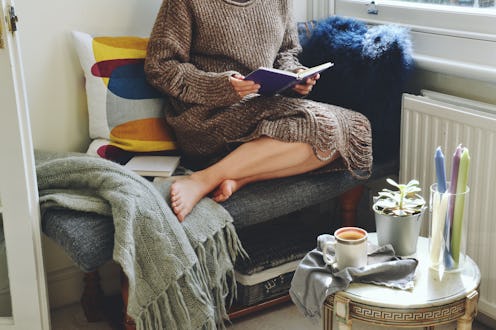(Living)
This Decor Essential Can Create A Cozy Nook Even For Those Short On Space

You've probably never given so much thought to every nook and cranny of your home as you have the last several months — now that you've got more time around the house to analyze them. Since you've likely been spending more quality time there, it's essential that you make your space as conducive to peace and tranquility as possible. That said, you may have wondered how to create a cozy corner like the plant and pillow-filled nooks you've seen in the homes of your favorite design influencers, especially if you're short on square footage.
The good news is, even for those living in the smallest of spaces, it is possible to carve yourself out a designated spot to soak up a book, sip a cup of tea, practice daily meditation, or whatever other purpose you want your cozy corner to serve. According to interior designers, there are some key tips and decor essentials that can instantly transform any spot into a zen zone — and they don't have to cost you a lot of money.
Having a cozy corner is an especially big fall 2020 trend (just think of the pumpkin spice candles and weighted blankets you could be enjoying there in colder months) but it's also something you can enjoy year-round, especially now, when you need a little respite without actually being able to go anywhere. If creating your very own sounds like an ideal weekend project to tackle, you're in luck. Ahead, some talented designers offer five suggestions for how to make yourself a sanctuary even if you're working with super limited space — plus shop a few products that can instantly get you the look and feel.
We only include products that have been independently selected by The Zoe Report's editorial team. However, we may receive a portion of sales if you purchase a product through a link in this article.
How To Create A Cozy Corner: Look For The Light
Want a good place to curl up and tuck into a good book? Or practice morning meditation? You'll need some good light. "I would look for a destination spot in my home that gets good light depending on the time of day that you will most likely use it," explains Anne Carr of Anne Carr Design. "If you like to be alone early in the morning, make sure your spot gets morning light." Designate a space close to a window if you've got one.
How To Create A Cozy Corner: Carefully Consider Fabrics
"In general, the fabric and style dictate the overall tone of the space," says Meghan Hackett-Cassidy of Hackett Interiors. "For a cozy nook, implement warm colors and textures in your window coverings for a backdrop." And the same idea can be applied to any other textiles you include in the space.
How To Create A Cozy Corner: Pad With Pillows
"A cozy corner isn't complete without a cozy pillow," says Lauren Meichtry, founder of Elsie Home. "However, it's important not to overcrowd your space (especially a small space) with too many pillows. If you can't sit comfortably, try removing a pillow or two to find that sweet spot that's just cozy enough, while also staying functional."
How To Create A Cozy Corner: Utilize Baskets
For the smallest of spaces, Meichtry suggests crafting a 'cozy basket' to store your blankets, pillows, and any other personal cozy necessities. "With an easy-to-move basket like this, you'll have a ready-made cozy spot whenever and wherever you need it," she explains.
How To Create A Cozy Corner: Create Mood With A Candle
Don't forget to include all the senses in creating a cozy experience — especially scent, which can be totally transformative. "A candle [...] will create a relaxing atmosphere and make it feel like your personal sanctuary," says Carr.
How To Create A Cozy Corner: Set It Off With Wallpaper
Lance Thomas of Thomas Guy Interiors suggests going big in a small space, which you can easily do with some removable wallpaper. "We recommend adding large-scale wall coverings in a small space," he says. "A small space allows you to make a huge statement without a large credit card statement." And it's also cost effective to use more luxurious materials here. "Fewer walls mean less wall covering to purchase," he adds.
This article was originally published on